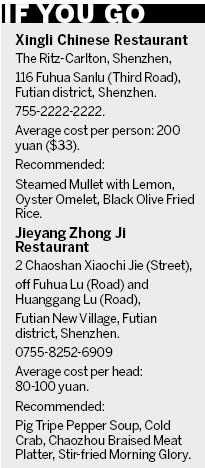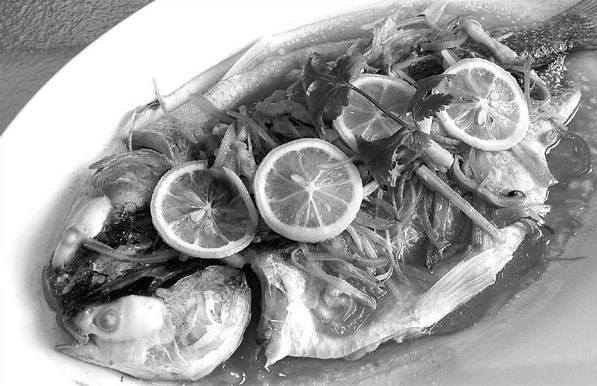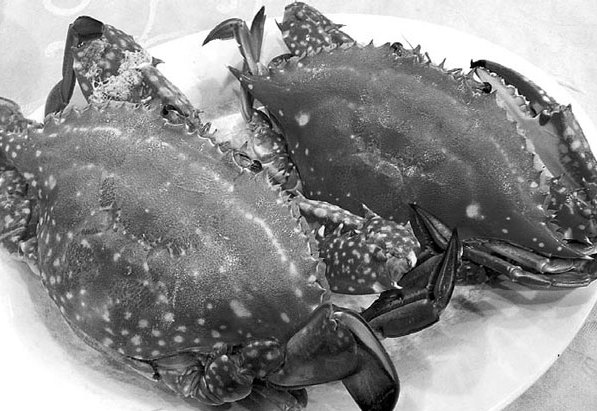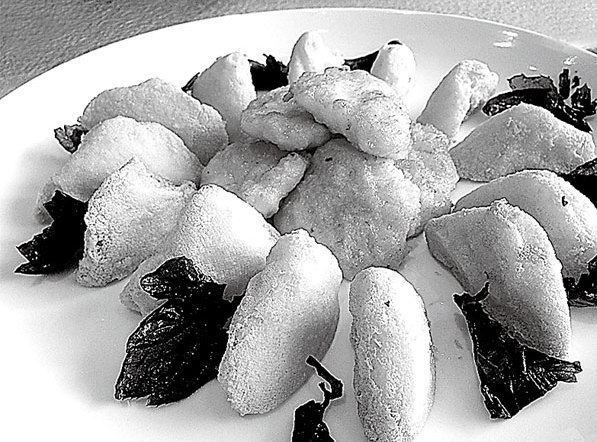Eating Chaozhou in Shenzhen
Updated: 2014-01-19 07:20
By Pauline D. Loh(China Daily)
|
|||||||
|
A black mullet is steamed with pickled and fresh lemons, which adds both fragrance and flavor, at the Xingli Chinese Restaurant. Photos by Pauline D. Loh / China Daily |
|
The steamed crabs served at Jieyang Zhong Ji Restaurant are fat and solidly packed with sweet meat. |
|
An arrangement of deep-fried tofu and squid fritters. |
Immigrant cities have the good fortune to enjoy diverse cuisines that arrive with their guest workers, and Shenzhen is no different. Pauline D. Loh goes local with grassroots delicacies.
It was an unexpected pleasure and a delicious surprise. A trip to the young southern city of Shenzhen became a gourmet excursion recently with the discovery of some top-end Chaozhou dishes at a Chinese restaurant, and a rustic locals-only food street.
Chaozhou is a region that is technically part of Guangdong province, but in all respects, including cuisine and language, it is closer to Fujian just across the provincial line.
A coastal county known for its hard-working, frugal businessmen and entrepreneurs, Chaozhou is motherland to many of the world's richest Chinese tycoons, whatever their nationalities.
This famous thriftiness extends to the kitchen, and seafood takes on a totally new meaning, with great ingenuity going into the dishes to extract every atom of goodness from the ingredients.
Take paste made from the cheaper varieties of fish that is shaped into croquettes, batons and balls. Chaozhou's "fishballs" are famous and they also make a unique dumpling with skin made from the same fish paste, but beaten into a springy, chewy tactile delight.
Shenzhen is a relatively new city, and many migrant workers from neighboring Chaozhou recognized the opportunities early. So it is that Chaozhou cuisine is as much a part of Shenzhen as its native Cantonese food.
There is a tiny street in the city that has a whole row of Chaozhou restaurants a little-known gourmet paradise only real Shenzhen natives patronize.
Not far from the prosperous commercial hub of Futian and its exhibition and convention center, Futian New Village is a different world altogether. It was here that the first immigrants came to stock up on groceries from home, and slowly, the first Chaozhou eateries set up shop first as little hole-in-the-wall stalls, then as bigger restaurants with proper dining halls.
We visited on a weeknight but the lights were blazing and the crowds were hungry.
There are several restaurants in the cluster, but the one we visited was obviously the largest and most popular and its name, Jieyang Zhong Ji Restaurant, proudly advertises its regional specialties.
It had stacked aquariums full of fresh seafood, including local salt-water fishes and prawns, varieties of crabs and an impressive display of all types of shellfish. This is where you point and order, and get into a lively discussion with the stall-owner on how best to enjoy it all.
Generally, Chaozhou flavors are subtle, and seafood is best steamed or lightly seasoned so you can enjoy the natural sweetness. The famous steamed Chaozhou cold crab is a fine example.

First on our table was a steaming hot clay pot of pig tripe soup flavored with whole white peppercorns. The spicy fragrance lifted our appetite immediately and on a cold winter night, that bowl of milky tonic was very much appreciated.
A plate of stir-fried morning glory and a platter of braised meats appeared next.
The morning glory, also known as water convolvulus or kangkong, is an all-season standby that is cheap and plentiful. Flavored with spicy prawn paste or fermented bean curd sauces, it becomes a delicious plate of greens.
The braised platter included black pudding, duck's webs, pig intestines and a couple of gizzards. This is yet another dish that reflects the Chaozhou principle of letting nothing go to waste. Every part of animal, mineral or plant is eaten.
Tougher cuts are braised and slowly cooked in a soy sauce broth until they are tender and delicious. The savory pieces of meat are eaten with rice congee in yet another way to stretch the dollar.
The cold crab was sold out that day, even though we had arrived pretty early, which I guess, is testimony to its popularity. Instead, we had two blue swimmers steamed and they came, fat and solidly packed with sweet meat.
We also ordered a type of little red bream fried and served with a saucer of Chaozhou salted beans. This used to be a very cheap fish, although nothing from the sea is cheap anymore. It is a sweet fish with flaky meat and for this reason, the Cantonese nicknamed it "big-eyed chicken".
At the other end of the scale, Chao-zhou food is definitely the main attraction at Xingli Chinese Restaurant, the Ritz-Carlton Shenzhen.
It is probably because the hotel sits on property owned by a Chaozhou tycoon, but also because this cuisine is one of the rare ones that can stand up against Cantonese competition.
Xingli loses none of the authenticity even though its decor and comfort levels are far above those of Futian New Village.
Here, the steamed fish we are offered is another Chaozhou specialty, a black mullet steamed with pickled and fresh lemons. The fish is neatly split in half for easy cooking and garnished with plenty of shredded ginger and chili before being topped with lemon slices.
The mullet is a white fish and most of its oil reserves are found in its stomach. Steaming it with lemon adds both fragrance and flavor and this is a time-tested method favored by Chaozhou chefs.
Next up is an arrangement of deep-fried tofu and squid fritters, a variation of the fish paste. It was hard to decide which was better. The squid croquettes sprang back from the teeth and were declared a universal favorite by all at the table, but the tofu was like Cinderella at the ball.

The simplest is usually the hardest to do well, and the tofu wedges got my vote. Light and crisp on the outside, the fried tofu fritters were juicy at first bite. Dipped into the vinegar, garlic and chili sauce, they were addictive.
My favorite among all of Chaozhou's well-known offerings is the oyster omelet and Xingli's version gets my vote. Every oyster was plump and sweet and the omelet was fluffy and well seasoned. Most of all, it did not leave a layer of oil on the palate.
Finally, the dish to recommend at Xingli would be the black olive fried rice, which can be a meal by itself. It is both light and savory and very satisfying. You don't see much meat in this dish, but that's because the taste of the preserved olives adds enough robustness to the rice.
It is a shame that we do not see this dish too often at Chaozhou restaurants in China. In Thailand, olive fried rice is practically a national signature, along with tom yum soup, and it is all thanks to Chaozhou immigrants.
Good food prevails, and we can only count ourselves very fortunate that the current mobility around China has helped us reap unexpected epicurean rewards. Seize the day, or rather, the menu.
Contact the writer at paulined@chinadaily.com.cn.
(China Daily 01/19/2014 page8)


